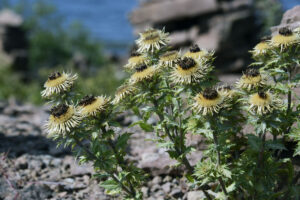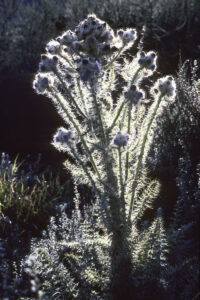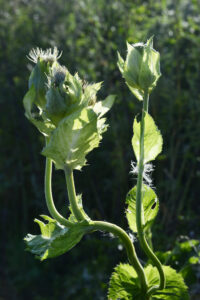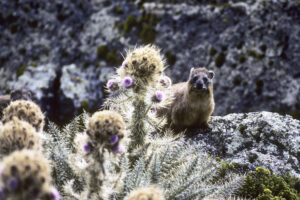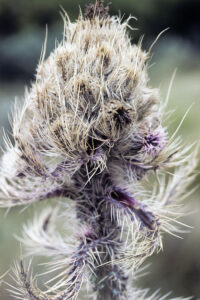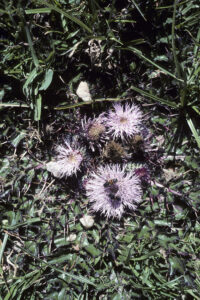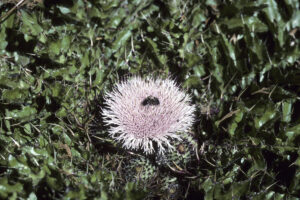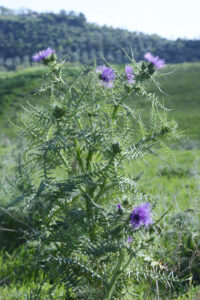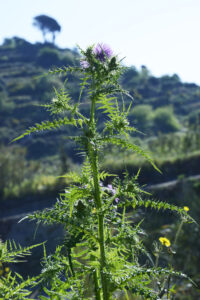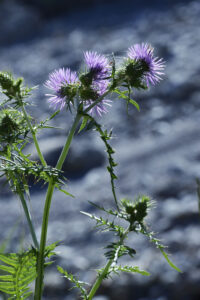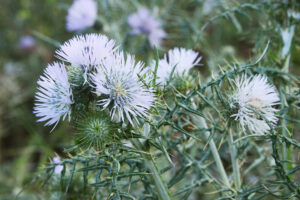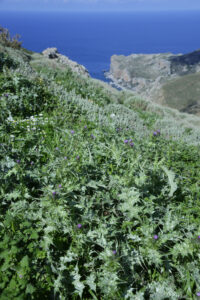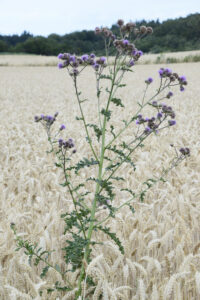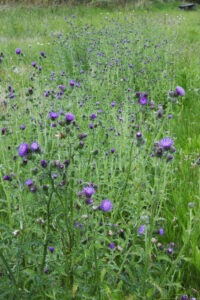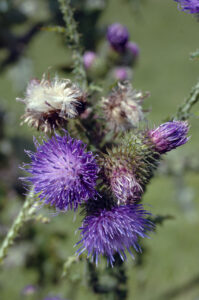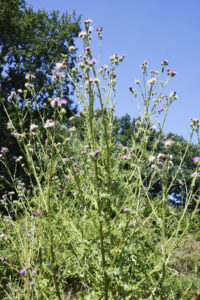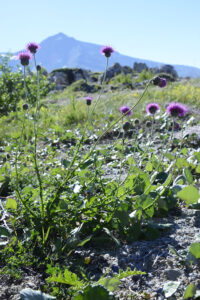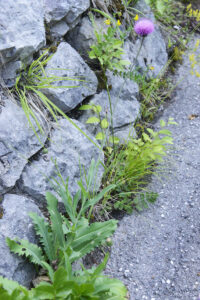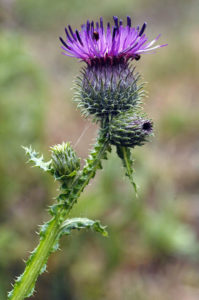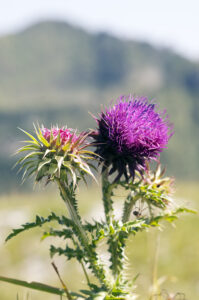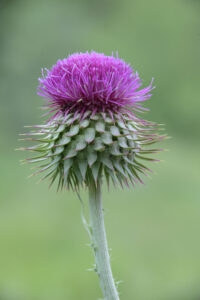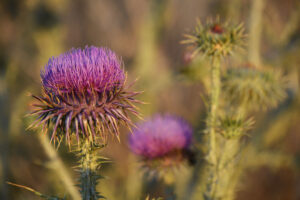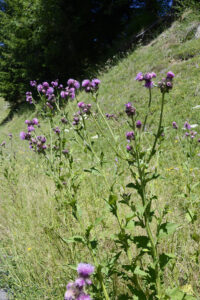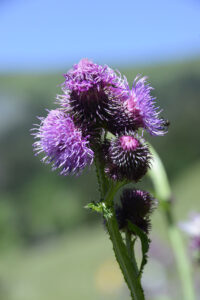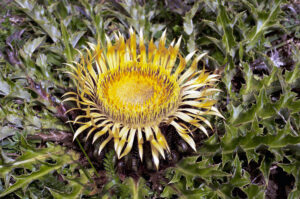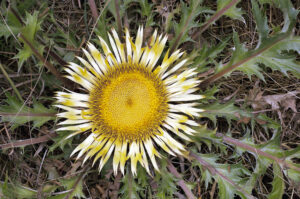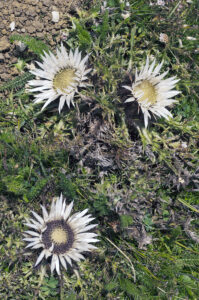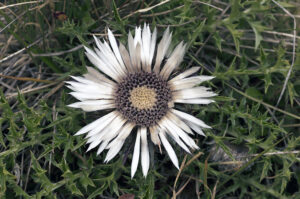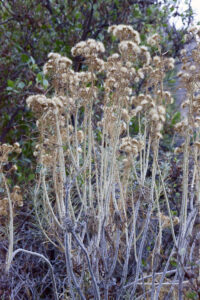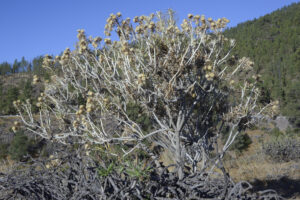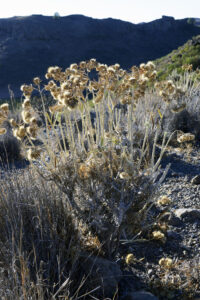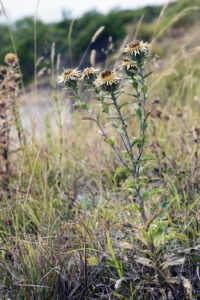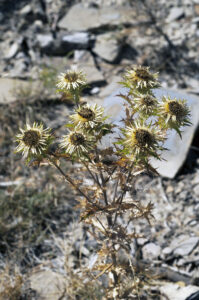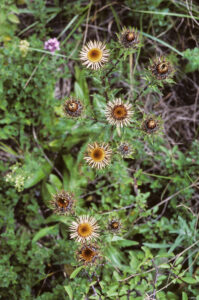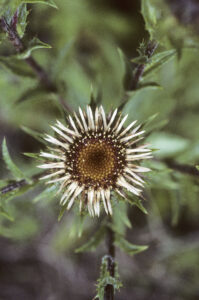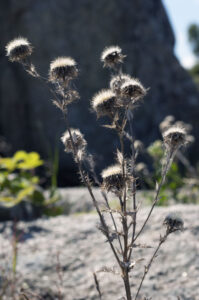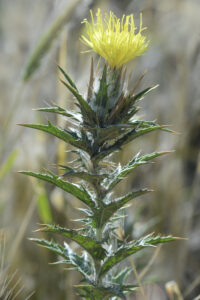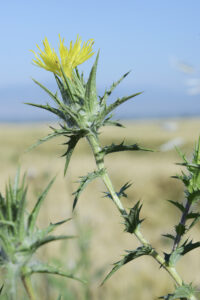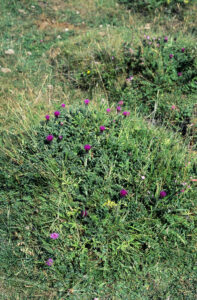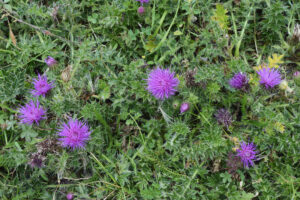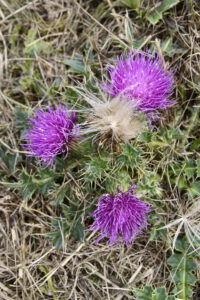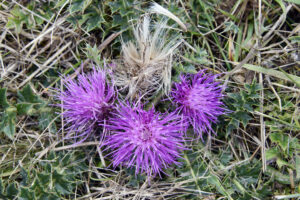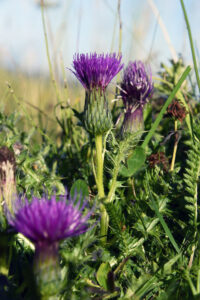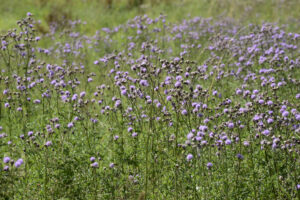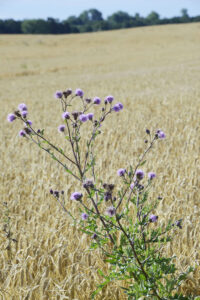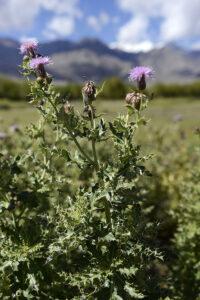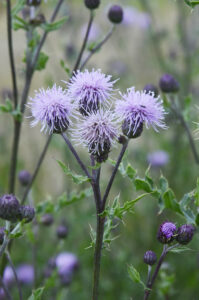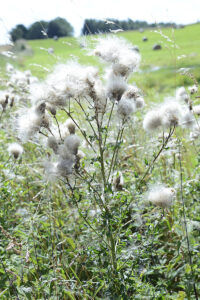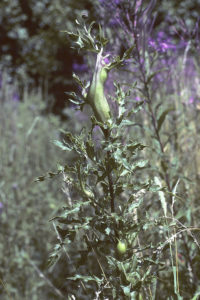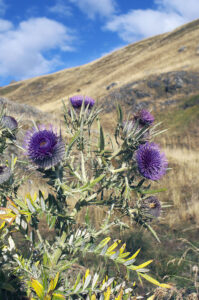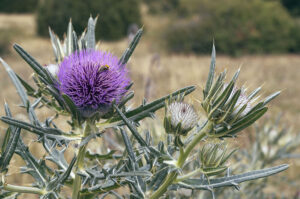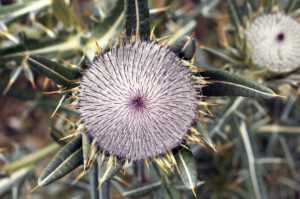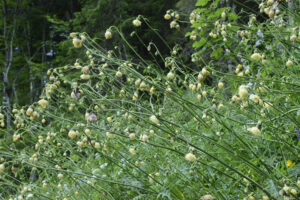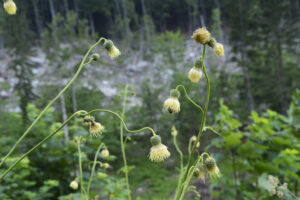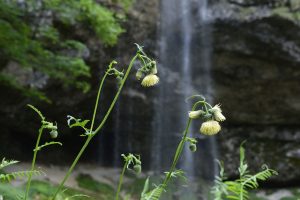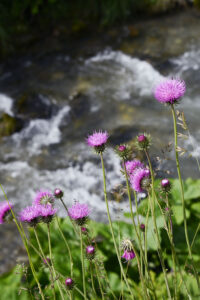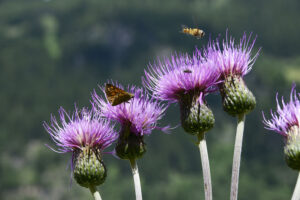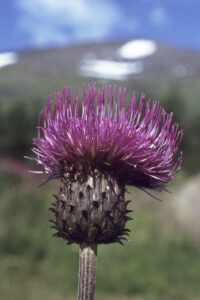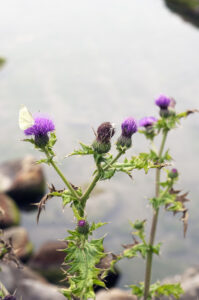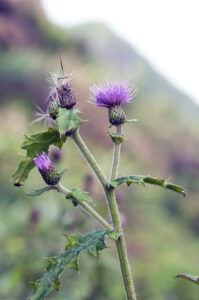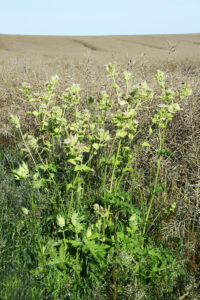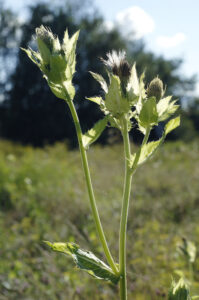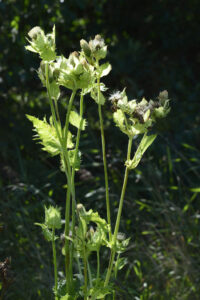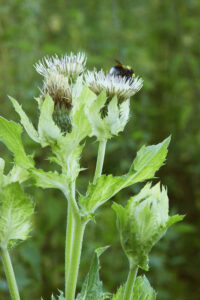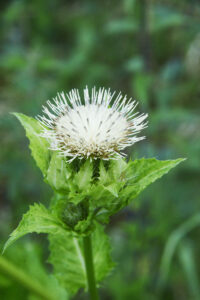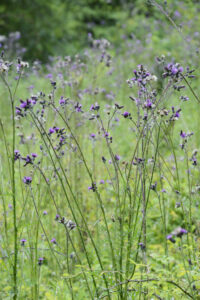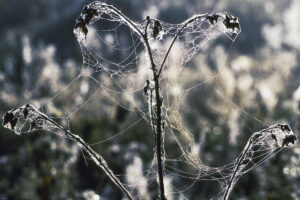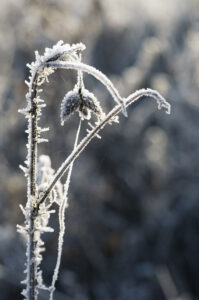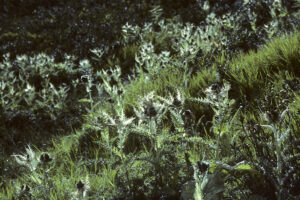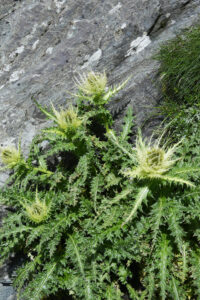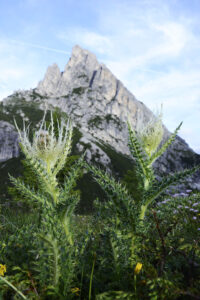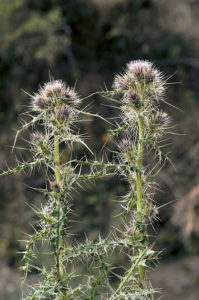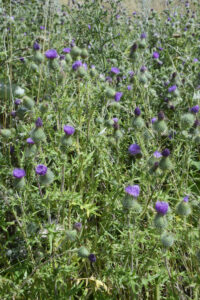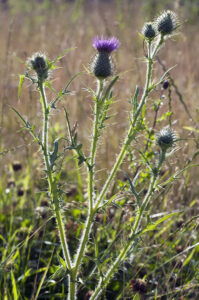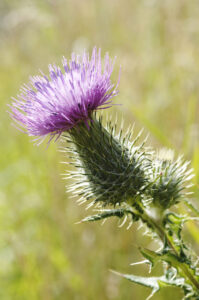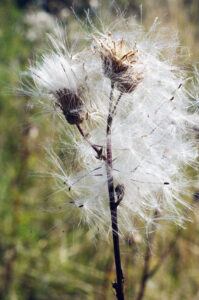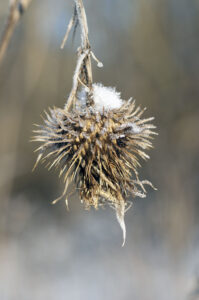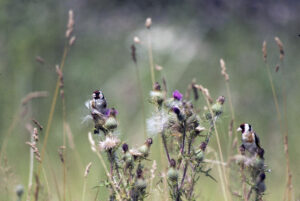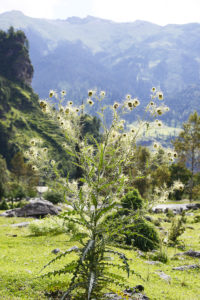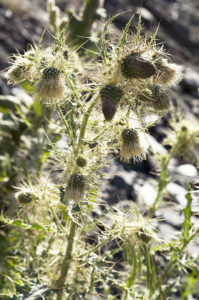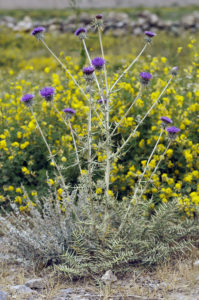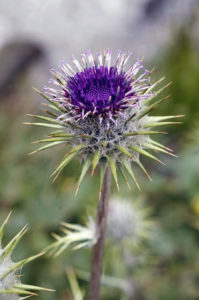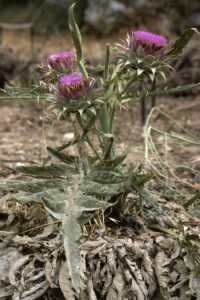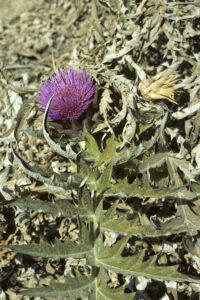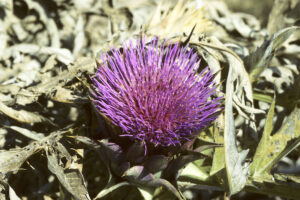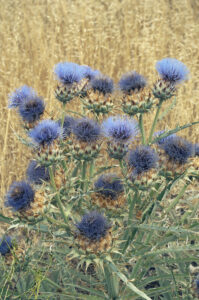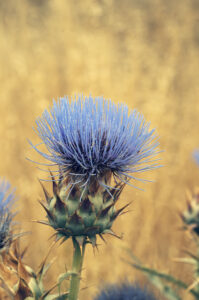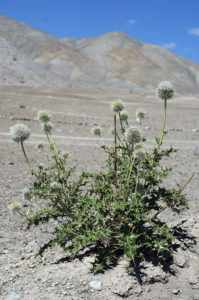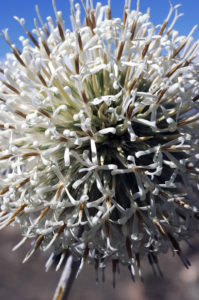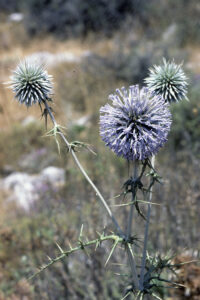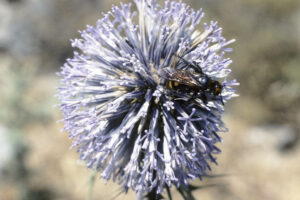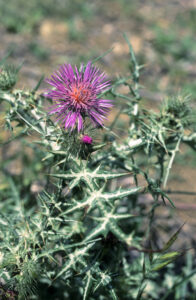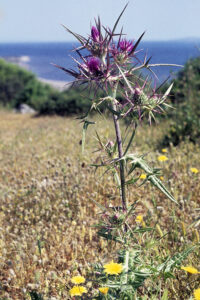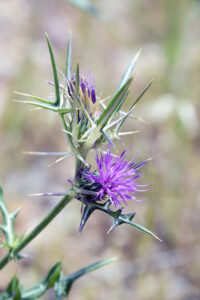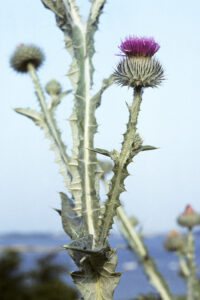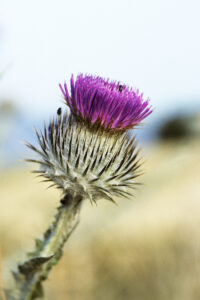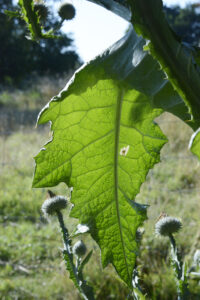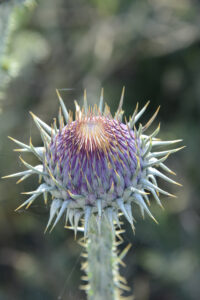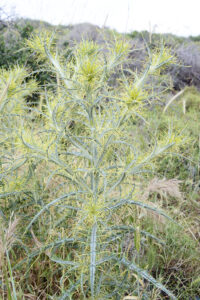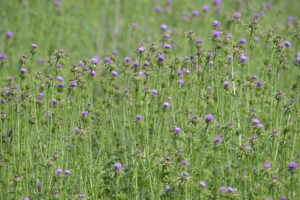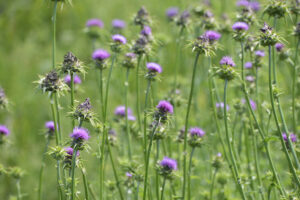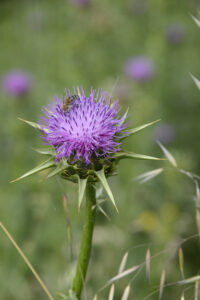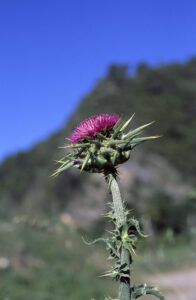Thistles
Bull thistle (Cirsium vulgare), Horsens, Jutland, Denmark. (Photo copyright © by Kaj Halberg)
Common carline thistle (Carlina vulgaris), Djupvik, Öland, Sweden. (Photo copyright © by Kaj Halberg)
Echinops cornigerus is very common in Ladakh, northern India, here photographed near Leh, the capital. (Photo copyright © by Kaj Halberg)
Afrocarduus keniensis, Mount Kenya. (Photo copyright © by Kaj Halberg)
Cabbage thistle (Cirsium oleraceum), eastern Funen, Denmark. (Photo copyright © by Kaj Halberg)
Thistles are despised among most people: they are extremely spiny, and several species are noxious weeds. The truth is, however, that most thistles have very beautiful composite inflorescences, which are very popular nectar and pollen plants among butterflies, bees, and hover flies. In autumn and winter, seeds of several species are popular food items for various finches, especially goldfinch (Carduelis carduelis) and linnet (Linaria cannabina).
Strictly speaking, in a botanical context, thistles are members of the genera Afrocarduus, Carduus, Carlina, Carthamus, Cirsium, Cousinia, Galactites, Notobasis, Onopordum, Picnomon, Silybum, and others, all of the composite family (Asteraceae). On this page I also include certain other spiny, thistle-like plants of the composite family, namely Cynara (artichoke) and Echinops (globethistle).
In composites, the inflorescence consists of many individual flowers, called florets, which are grouped densely together to form a flower-like structure, the flowerhead, technically called the capitulum. The flowerhead is surrounded by an involucre, consisting of densely packed green bracts, often erroneously called a calyx. The central disc florets are symmetric, and the corolla is fused into a tube. The outer ray florets are asymmetric, the corolla having one large lobe, which is often erroneously called a petal.
In Japanese, thistles are often called azami, derived from azamuku (‘to deceive’), because the flowerheads are beautiful, but stem and leaves are filled with vicious spines.
Afrocarduus African thistles
This genus of 10 species was split from the genus Carduus in 2023. Members are found from Nigeria eastwards to Ethiopia, and thence southwards through eastern Africa to Zimbabwe. They grow in montane areas at elevations between 1,600 and 4,600 m. Some are restricted to a single mountain or mountain range, others are widespread.
The last part of the generic name is explained below, under Carduus.
Afrocarduus keniensis
A tall plant with a central stem, reaching a height of up to 1 m, and a panicle-like cluster of pink or pale purple flowerheads towards the apex. It has a basal rosette of pale green, pinnately divided leaves with short spines, whereas the stem leaves appear whitish due to the numerous, very long, white spines. The flowerheads are often almost concealed in these spines.
It is restricted to Mount Elgon on the border between Uganda and Kenya, Mount Kenya, and Mount Kilimanjaro and Mount Meru in northern Tanzania.
Large growth of Afrocarduus keniensis in morning light, Mount Kenya. (Photo copyright © by Kaj Halberg)
Afrocarduus keniensis, Mount Kenya. The animal is a black-necked rock hyrax (Procavia capensis ssp. johnstoni), by some authorities regarded as a separate species, named Procavia johnstoni. (Photo copyright © by Kaj Halberg)
Afrocarduus keniensis, Mount Kenya. (Photos copyright © by Kaj Halberg)
Afrocarduus schimperi
This prostrate species, previously known as Carduus chamaecephalus, grows in mountain areas, from Ethiopia and South Sudan southwards to Uganda, Kenya, eastern Zaire, and northern Tanzania. It has a rosette of pinnately divided leaves, which are hugging the ground, and one or several central, pale purple flowerheads, to 3 cm across. It is common in alpine grasslands, at elevations between 3,000 and 3,500 m.
The specific name commemorates German botanist Georg Heinrich Wilhelm Schimper (1804-1878), who spent more than 40 years in Ethiopia collecting plants. He probably discovered more undescribed African plant species than any other botanist.
Afrocarduus schimperi, Kapsangar, Cherangani Hills, western Kenya. (Photos copyright © by Kaj Halberg)
Carduus Plumeless thistles
This genus of spiny herbs, comprising about 95 species, is widespread in Asia, Europe, and tropical Africa. These plants are very similar to thistles of the genus Cirsium (below), but differ in having simple seed hairs that do not form a plume.
Most species have dark purple flowers, but occasionally individuals with mauve or white flowers are seen. They only have disc florets, no ray florets.
The generic name is the classical Latin word for thistle, probably derived from the Sanskrit kasati (‘to scratch’), alluding to the spines.
Carduus acanthoides Spiny plumeless thistle
This plant, occasionally exceeding 2 m in height, has a winged stem with short spines, upper stem and side branches sometimes smooth. The leaves are very variable, narrowly or deeply pinnate, very spiny.
It is native from western and northern Europe across the Middle East, Kazakhstan, and Tibet to China, Korea, and Japan. It grows in a variety of habitats, including open grasslands, roadsides, pastures, and disturbed areas. It has been introduced to many other areas, including North America, where it is often regarded as an invasive species.
The specific name is an alternative, Latinized spelling form of Ancient Greek akanthodes (‘spiny’), derived from akantha (‘spine’) and odes (‘full of’), of course referring to the very spiny foliage.
Spiny plumeless thistle, south of Patti (top), and around Taormina, both in Sicily. (Photos copyright © by Kaj Halberg)
Spiny plumeless thistle with pale violet flowerheads, Terrasini, near Palermo, Sicily. (Photos copyright © by Kaj Halberg)
Carduus argentatus Silver thistle
This plant, easily identified by the white blotches on the leaves, is found around the eastern Mediterranean and further eastwards through Iraq to Pakistan and Afghanistan. It grows in open woodlands, shrublands, and desert areas, even in extreme conditions. In Crete, it is found up to elevations around 1,400 m.
The specific name is Latin, meaning ‘like silver’, alluding to the white spots on the leaves.
Silver thistle, near Sfinari, western Crete. (Photo copyright © by Kaj Halberg)
Carduus crispus Curly plumeless thistle, welted thistle
This species is native in the entire Europe, except the Mediterranean area, and thence eastwards across southern Siberia and Central Asia to the Pacific coast. It has been introduced to other areas, and is considered a noxious weed in North America.
It is typically to about 1.8 m tall, but may occasionally be up to 3 m. The leaves are more or less lobed with weak spines along the edge, and the stem may be spiny or smooth. It grows in open areas, such as grasslands, pastures, and along roads.
The specific name is Latin, meaning ‘curly’ or ‘wavy’, alluding to the leaves.
Welted thistle, eastern Funen (upper 2), and Roskilde Fjord, Zealand, both Denmark. (Photos copyright © by Kaj Halberg)
Welted thistle with seeds, Nature Reserve Vorsø, Horsens Fjord, Denmark. (Photo copyright © by Kaj Halberg)
Carduus defloratus Alpine thistle
This plant is very variable, especially regarding the shape of the leaves, and it has been divided into at least 8 subspecies, of which some may be separate species.
The stem is usually to 50 cm tall, sometimes up to 90 cm, slightly arching, branched, smooth or sometimes winged with thorns, upper part mostly without leaves, thorns, and wings. Leaves are very variable, hairless, sessile, blade entire or pinnate, sometimes toothed.
This species differs from other members of the genus in having only a single purplish-red flowerhead, to 3 cm across, at the end of each branch. Initially, it is erect, later often nodding. Involucral bracts are spreading, unlike the rather similar Cirsium tuberosum.
It is partial to rocky limestone areas, from the lower valleys up to an altitude of about 3,000 m, distributed from the Pyrenees via the Alps to the northern Balkan Peninsula and the Carpathians.
The specific name means something like ‘to deprive of flowers’ – indeed a strange name, as it has lots of flowers.
Alpine thistle, a subspecies with spiny wings on the stem, Col du Mt. Cenis, France. (Photo copyright © by Kaj Halberg)
Alpine thistle, subspecies glaucus, which has very few spines, Trenta Valley, Triglavski National Park, Slovenia. (Photo copyright © by Kaj Halberg)
Carduus edelbergii
This stout, spiny plant, to 1.2 m tall, was previously regarded as a variety, var. lucidus, of the widespread musk thistle (C. nutans, below). The leaves are pinnately lobed, very spiny, to 10 cm long, decurrent. The large flowerheads, to 4 cm across, are born singly. They are crimson, rarely white.
It is native from Afghanistan eastwards to western Nepal, growing in open areas at altitudes between 1,500 and 4,500 m
The specific name commemorates Danish botanist, geographer, and anthropologist Lennart Edelberg (1915-1981), who participated in three expeditions to Afghanistan, in 1948-1949, 1953-1954, and 1964.
Carduus edelbergii, Kielang, Himachal Pradesh, India. (Photo copyright © by Kaj Halberg)
Carduus edelbergii, Sissu, Lahaul, Himachal Pradesh. (Photo copyright © by Kaj Halberg)
Carduus nutans Musk thistle, nodding thistle
The native range of this impressive plant is from the entire Europe eastwards to eastern Siberia, southwards to the Mediterranean, Iran, Xinjiang, and Mongolia. It has become naturalized in North America and Australia, where it is considered a noxious weed.
It grows in open areas, preferably on disturbed ground, such as fallow fields, pastures, landslides, abandoned plots, and along roads, from the lowlands up to an elevation of about 2,500 m, preferably on neutral or acidic soils.
In colder regions, this plant is a biennial, requiring 2 years to complete a reproductive cycle, overwintering as a rosette. It may grow to more than 2.5 m tall, stem often woolly, winged, heavily armed with green or whitish spines, to 1 cm long, less armed above, where it may be completely thornless. All leaves are very spiny, basal ones tapering to winged stalks, blade to 4 cm long, once or twice pinnately lobed, stem leaves stalkless, shorter. Flowerheads are borne singly at the end of the stem or on spreading branches, to 4 cm across, initially upright, later often nodding. The involucre is hemispheric, to 6 cm long and 7 cm wide, with lanceolate to ovate, very stiff, spreading or reflexed bracts, to 1 cm long. Disc florets are very numerous, purplish-red, to 2.8 cm long.
The specific name is Latin, meaning ‘nodding’, referring to the often nodding flowerheads.
Large growth of musk thistle, near Aksaray, east of Konya, Turkey. A few poppies (Papaver) are also seen. (Photo copyright © by Kaj Halberg)
Musk thistle, Fårö, Gotland, Sweden. (Photo copyright © by Kaj Halberg)
Musk thistle, Gourette, near Col d’Aubisque, Pyrenees. (Photo copyright © by Kaj Halberg)
Musk thistle, Boz Dağları, southeast of Manisa, Turkey. (Photos copyright © by Kaj Halberg)
Musk thistle in evening sun, Pamukkale, Turkey. (Photos copyright © by Kaj Halberg)
Carduus personata
This species occurs in mountains of central Europe, in the Alps, the Apennines, the Carpathians, the Sudetes, and also in the Balkans. It mainly grows in moist and nutritious soils, including meadows, humid woodlands, and along streams, preferably in partial shade. In the Alps, it may be found at altitudes between 500 and 2,300 m.
The spines of this plant are rather soft. It has a sturdy stem, varying in height between 40 cm and 1.6 m, widely branched towards the apex, winged, with fine spines along the edge of the ribs. The leaves are all stem leaves, ovate or lanceolate, soft and curly, with fine spines along the margin, the lower ones to 35 cm long and 20 cm wide, gradually getting smaller up the stem.
The flowerheads are densely clustered at the apex of stem and branches, 2-5 together, to 2.5 cm across, disc florets violet-purple.
The specific name is derived from the Latin personatus (‘masked’), presumably alluding to the very dark involucral bracts.
Carduus personata, Col de la Croix, Valais, Switzerland. (Photos copyright © by Kaj Halberg)
Carlina Carline thistles
This genus, comprising about 30 species, is distributed from Madeira and the Canary Islands eastwards across Europe and northern Africa to Siberia and north-western China.
The flowerhead has several rows of bracts, of which the outer ones are leaf-like with spine-like tips, whereas the inner rows have ray-like, whitish or yellowish bracts, which are hygroscopic. In dry weather they are spread out fan-like, announcing to bees and hover flies that food is available here, whereas in damp weather they fold up to protect the true florets in the centre of the flowerhead. In folklore, this was seen as a sign of forthcoming rain.
The generic name was given in honour of Holy Roman Emperor, Archduke of Austria, King of Spain, and Lord of the Netherlands, Karl V (1500-1558), also called Charlemagne or Charles the Great, in Latin Carolus. As legend has it, he used the root of Carlina acaulis (below) to cure disease among his soldiers.
Carlina acanthifolia Acanthus-leaved thistle
The straw-coloured flowerheads of this spectacular plant may grow to 20 cm across, centered in a profusion of spiny leaves, to 50 cm long, which somewhat resemble those of spiny acanthus (Acanthus spinosus). The plant is usually stemless, but sometimes with a short stem up to 20 cm.
Divided into 4 subspecies, it is distributed from the Pyrenees eastwards to the Balkans, and thence northwards to Poland and Ukraine. The nominate subspecies is quite common in the Pyrenees.
Acanthus-leaved thistle, Col du Pourtalet, Pyrenees. (Photo copyright © by Kaj Halberg)
Acanthus-leaved thistle, Alto Gallego, Aragon, Spain. (Photo copyright © by Kaj Halberg)
Acanthus-leaved thistle with a closed flowerhead, Valle Tena, near El Formigal, Aragon, Spain. In folklore, this was seen as a sign of forthcoming rain. (Photo copyright © by Kaj Halberg)
Carlina acaulis Stemless carline thistle, dwarf carline thistle
This is another stemless, spiny plant with the pinnately divided, spiny leaves growing in a rosette to 30 cm in diameter, having a flowerhead in the centre, to 10 cm across, with silvery-white bracts, surrounding the yellowish-brown disc florets.
This plant is distributed in the major part of central and southern Europe, eastwards to Belarus and Ukraine, with an isolated population in the Caucasus. It grows in dry grasslands, preferably on calcareous soil, from the valleys up to an altitude of about 2,800 m.
The rhizome contains a number of essential oils and was formerly used as a diuretic and to treat colds. Young buds of the flowerheads can be cooked and eaten, similar to artichokes (Cynara cardunculus, see below), which earned it the nickname hunter’s bread.
The specific name is Latin, meaning ‘stemless’, from a (‘without’) and caulis (‘stem’).
Stemless carline thistle, St. Martin, Navarra, Spain. (Photo copyright © by Kaj Halberg)
Stemless carline thistle, Alto Gallego, Aragon, Spain. (Photo copyright © by Kaj Halberg)
Stemless carline thistle with a bumble bee, Col du Pourtalet, Pyrenees, France. (Photo copyright © by Kaj Halberg)
Carlina canariensis Gran Canaria carline thistle
A shrub to 1 m tall, with numerous erect stems from the base, thin, brittle, covered in whitish hairs and armed with short spines. The leaves are simple, linear-lanceolate, glossy dark green to olive-yellow above, woolly below, to 12 cm long and 8 mm wide, margin with long and very sharp spines. Flowerheads are globular, in clusters of 10-15, long-stalked, yellowish, to 3 cm across, woolly, surrounded by pointed, spiny bracts.
This plant is endemic to Gran Canaria, usually found in stony areas at elevations between 300 and 1,000 m in the southern and south-western parts of the island. At the highest altitudes, it hybridizes with C. texedae (below).
In some locations, its flowers are mixed with the classic goat rennet to curdle milk to make cheese. It has also been used for dyeing. Medicinally, an infusion of the leaves and flowers is used as a mild purgative and to relieve muscle spasms.
It is threatened due to overgrazing by goats, as they browse on tender shoots.
Gran Canaria carline thistle in the fruiting stage, Barranco Mogán, Gran Canaria. (Photo copyright © by Kaj Halberg)
Carlina texedae
Another Gran Canaria endemic, growing on slopes above elevations of 1000 m in the central-southern areas of the island. It is a shrub, to 80 cm tall, many-branched from the base, leaves greyish-green above and with whitish hairs below, linear, margin wavy, with fine, long, spiny teeth. Inflorescences are on the terminal branches, flowerheads to about 2 cm across, flowers yellowish, outer involucral bracts ovate or lanceolate.
Carlina texedae in the fruiting stage, Plateau Presa de las Niñas, Gran Canaria. (Photos copyright © by Kaj Halberg)
Carlina vulgaris Common carline thistle
Mostly a low plant, but may occasionally reach a height of 60 cm. The leaves are lanceolate, toothed or pinnately divided, thick, smooth, shiny, and with spines. Flowerheads are terminal on sidebranches, each one a cluster of very small, brown florets, surrounded by brownish-yellowish bracts. The flowerheads seem dry, even when flowering, so at first glance the plants appear to be withering.
It is native to almost the entire Europe and the Middle East, eastwards to Ukraine, Iran, and Turkmenistan. It has also been introduced to eastern United States. It grows in calcareous areas, on hillsides, and in grasslands and dunes.
The specific name is Latin, meaning ‘common’.
Common carline thistle, Mols, Denmark. (Photo copyright © by Kaj Halberg)
Common carline thistle, Valle Hecho, Pyrenees, Spain. (Photo copyright © by Kaj Halberg)
Common carline thistle, Stora Alvaret, Öland, Sweden. (Photo copyright © by Kaj Halberg)
Common carline thistle, Djursland, Denmark. (Photos copyright © by Kaj Halberg)
Fruiting stage of common carline thistle, Svaneke, Bornholm, Denmark. (Photo copyright © by Kaj Halberg)
Carthamus Distaff thistles
This genus, containing about 40 species, is found from western Europe eastwards to Kazakhstan, southwards to northern and north-eastern Africa, Arabia, and the Himalaya. Several species have become naturalized elsewhere around the world.
The generic name can be traced back to classical Syriac qurtema, the name of the safflower (C. tinctorius), originally from qartem (‘to cut off gently’), alluding to the picking of the florets of this species, which are used for dyeing. The common name presumably refers to these plants being used as distaffs, i.e. a device to keep the unspun fibres from being entangled before they were spun into thread.
Carthamus lanatus Woolly distaff thistle
A very spiny plant, to 75 cm tall, stems often many together, forming an impenetrable thicket, variable in colour, green, brownish, or straw-coloured, sometimes so densely hairy that it seems to be covered in spiders’ webs. Stem leaves glandular-hairy, green, to 6 cm long and 2 cm wide, ovate in outline, lobed or pinnately divided, margin densely spiny. Florets pale yellow, outer ones to 4.5 cm long, often recurved, inner ones to 3 cm long, erect.
It is native from the British Isles eastwards to Belarus and Kazakhstan, southwards to northern Africa, Iran, and the Himalaya, growing in dry areas, including fallow fields and waste places.
The specific name is Latin, meaning ‘woolly’, referring to the densely woolly lower stem.
Some authorities place this plant in the genus Phonus.
Woolly distaff thistle, Pamukkale, western Turkey. (Photos copyright © by Kaj Halberg)
Cirsium Thistle
A huge genus of spiny herbs with about 400 species, distributed in temperate and subarctic regions of Eurasia, northern and eastern Africa, and Central and North America, southwards to Columbia, Zambia, the Malay Peninsula, and the Philippines.
These plants are very similar to thistles of the genus Carduus (above), but differ by their seed hairs forming a plume, whereas seed hairs of members of Carduus do not form a plume. The flowerheads only have disc florets, no ray florets.
The generic name is derived from Ancient Greek kirsion, according to Greek physician, pharmacologist, and botanist Pedanius Dioscorides (died 90 A.D.) the name of a kind of thistle, derived from kirsos (‘swollen vein’), alluding to its usage against swollen veins.
Cirsium acaule Stemless thistle, dwarf thistle
Plant with a rosette of deep green, spiny leaves, to 15 cm long, and usually a solitary purplish-red flowerhead, to 4 cm across, borne from the centre of the rosette. As its name implies, this species is stemless, but may occasionally be up to 20 cm tall.
It is widespread in the major part of Europe, eastwards to the Baltic states and Romania, growing in grasslands with short vegetation, mainly on calcareous soil.
The specific name is Latin, meaning ‘stemless’, from a (‘without’) and caulis (‘stem’).
In this picture, stemless thistle is growing on hills of yellow meadow ant (Lasius flavus) in a littoral meadow, Monnet, Tåsinge, Funen, Denmark. Other plants include common restharrow (Ononis spinosa ssp. maritima), brown knapweed (Centaurea jacea), and creeping cinquefoil (Potentilla reptans). (Photo copyright © by Kaj Halberg)
Stemless thistle, Jydelejet, Møn, Denmark. (Photo copyright © by Kaj Halberg)
Stemless thistle, Seby Gravfält, near Segerstad, Öland, Sweden. (Photos copyright © by Kaj Halberg)
Some individuals of stemless thistle have a short stem, to 20 cm high. This one was photographed near Halltorps Hage, Öland, Sweden. (Photo copyright © by Kaj Halberg)
Fruiting stemless thistle, Valsaparence, Gran Paradiso National Park, Italy. (Photo copyright © by Kaj Halberg)
Cirsium arvense Creeping thistle, Canada thistle
This proliferous spiny herb, to 1.6 m tall, is found in most temperate areas of Europe and Asia, and has also been accidentally spread to many other places around the globe. It may be separated from most other thistles by the rather small purplish, violet, or pink (rarely white) flowerheads, 1-2 cm across.
It grows in open areas and is a most troublesome weed in fields in most cooler parts of the world. As far back as 1863, Danish research showed that a large creeping thistle can produce about 80 flowerheads in one season, and as flowerheads on average contain 120 flowers, one single plant is able to produce about 10,000 seeds per year! It also spreads via underground stems. Its invasiveness is described in depth on the page Nature: Invasive species.
In Nepal, a paste of the root is used for indigestion.
The specific name is Latin, meaning ‘growing in fields’.
Large growths of creeping thistle, eastern Funen, Denmark. (Photos copyright © by Kaj Halberg)
Creeping thistle, growing in a field of barley, eastern Funen. (Photo copyright © by Kaj Halberg)
Creeping thistle, near Shey Palace, Ladakh, northern India. (Photo copyright © by Kaj Halberg)
Close-up of flowerheads, eastern Funen, Denmark. (Photo copyright © by Kaj Halberg)
One individual creeping thistle can spread up to 10,000 seeds per season. – Eastern Funen (top), and northern Zealand, both Denmark. (Photos copyright © by Kaj Halberg)
Many individuals of creeping thistle are infested with galls, made by larvae of the thistle stem gall fly (Urophora cardui). – Nature Reserve Vorsø, Horsens Fjord, Denmark. (Photo copyright © by Kaj Halberg)
Cirsium eriophorum Woolly thistle
A stout biennial herb, to 1.5 m tall, densely woolly on the stem, with sharp yellow spines on the pinnate leaves, the lower ones reaching a length of up to 80 cm. Flowerheads large, nearly spherical, to 7 cm across, with purplish-red florets, involucre covered in a dense layer of woolly hairs, with short spines hidden among the wool. The flowers are much visited by bees, flies, beetles, butterflies, and moths.
This plant is widespread in Europe, found from the British Isles, Germany, and Poland southwards to the Mediterranean and Turkey, growing in open habitats, including grasslands, shrubberies, woodlands, and disturbed areas.
The young leaves may be eaten raw, and young stems are also edible after being soaked in water to remove their bitterness. The flower buds can be cooked, similar to artichokes (Cynara cardunculus, see below), and an edible oil is extracted from the seeds.
The specific name is derived from Ancient Greek erion (‘wool’) and phoros (‘bearing’), alluding to the dense cover of woolly hairs in the involucre.
Woolly thistle, Valle Tena, near El Formigal, Aragon, Spain. (Photos copyright © by Kaj Halberg)
Woolly thistle, Ibon de Piedrafita, Aragon. The bottom picture shows a closed flowerhead. (Photos copyright © by Kaj Halberg)
Cirsium erisithales Yellow melancholy thistle
This slender plant may reach a height of 1.5 m, with erect, almost hairless stems and few pinnately divided, unarmed leaves with toothed lobes. The nodding flowerheads are pale yellow or lemon-coloured, to 3 cm across, terminal, mostly solitary, but sometimes in groups up to 5.
It is widespread in southern and eastern Europe, found from the French Massif Central across the Alps eastwards to the Tatra Mountains, the Dinaric Alps, Greece, Ukraine, and European Russia. In the Alps, it is found at altitudes between 400 and 2,000 m.
The epithet melancholy alludes to the nodding flowerheads, which, apart from the colour, resemble those of the melancholy thistle (below).
Yellow melancholy thistle, Forni di Sopra, Dolomites, Italy. (Photo copyright © by Kaj Halberg)
Yellow melancholy thistle, near Bistrica, northern Slovenia. (Photo copyright © by Kaj Halberg)
Yellow melancholy thistle in front of the waterfall Fontanon di Goriude, Dolomites, Italy. (Photo copyright © by Kaj Halberg)
Cirsium helenioides Melancholy thistle
This species was previously known as C. heterophyllum, alluding to the leaves being of various shape. It is a spineless plant, growing to 1.2 m tall, often forming runners. The stem is grooved, downy, sometimes branched, leaves green and smooth above, with a thick layer of white felt beneath, basal leaves stalked, lanceolate, to 40 cm long and 8 cm wide, with soft prickles along the margin. Upper leaves are stalkless, clasping the stem with heart-shaped ears. Flowerheads conical, to 5 cm long and 3 cm wide, disc florets purplish-red, involucral bracts smooth, sometimes spreading.
This plant grows in grasslands, shrubberies, open woodland, and along roads and streams. It is native from northern Europe, including Scotland, eastwards across the major part of Siberia to Kazakhstan, Sinkiang, and Mongolia. It also occurs in montane areas of central and southern Europe, and in the Caucasus, and also a few places in Iceland and southern Greenland.
Formerly, this species was considered a possible cure for sadness. English herbalist Nicholas Culpeper (1616-1654) says that it, being drank in wine “expels superfluous melancholy out of the body and makes a man as merry as a cricket,” adding “Dioscorides* saith, the root borne about one doth the like, and removes all diseases of melancholy: Modern writers laugh at him: Let them laugh that win: my opinion is, that it is the best remedy against all melancholy diseases that grows.”
The specific name is Latin, meaning ‘like Helenium‘, alluding to the likeness of some leaf forms to those of the basal leaves of elecampane (Inula helenium, see Plants: Plants in folklore and poetry).
*Pedanius Dioscorides (died 90 A.D.), Greek physician, pharmacologist, and botanist, author of De Materia Medica, 5 volumes dealing with herbal medicine.
Melancholy thistle, Arabba, Dolomites, Italy. (Photo copyright © by Kaj Halberg)
Melancholy thistle is much visited by bees, hover flies, and butterflies. – Stubai Valley, Austria. (Photo copyright © by Kaj Halberg)
Melancholy thistle, northern Norway. (Photo copyright © by Kaj Halberg)
Cirsium japonicum Japanese thistle
This plant grows in grasslands and other open areas, and along roads and riverbanks, distributed from Japan, Korea, and central China southwards to northern Vietnam and Taiwan. It may grow to about 1 m tall, flowerheads reddish-purple, to 5 cm across.
Japanese thistle, Yeliou Geopark, northern Taiwan. (Photo copyright © by Kaj Halberg)
Japanese thistle, Nanya, northern Taiwan. (Photo copyright © by Kaj Halberg)
Cirsium oleraceum Cabbage thistle
This perennial grows to 1.5 m tall, stems erect, unbranched or with few branches, pale green, leaves likewise pale green, soft, lower ones ovate in outline, deeply lobed, lobes pointed, with weak spines at the tip. Upper leaves often undivided, heart-shaped, clasping the stem.
Flowerheads are terminal, to 4 cm across, 2-6 densely clustered, surrounded or even sometimes covered by large yellowish bracts. Florets pale yellow, sometimes tinged pink.
The cabbage thistle thrives in wet meadows, along streams, and in humid forests, often forming large stands with the help of underground stems. It is native from western Europe eastwards to western Siberia. In montane areas it is restricted to the lower areas, occasionally found up to an altitude of about 2,000 m.
The specific name is derived from the Latin holus, genitive holeris (‘vegetable’), alluding to the young stems and leaves being edible. The common name also refers to this usage. In Japan, it is still being cultivated as a vegetable.
Cabbage thistle, growing at the edge of a road, eastern Funen, Denmark. (Photo copyright © by Kaj Halberg)
Cabbage thistle, Veksø, northern Zealand, Denmark. (Photo copyright © by Kaj Halberg)
Cabbage thistle, eastern Funen, Denmark. (Photos copyright © by Kaj Halberg)
Cirsium palustre Marsh thistle
The stem of this species, to 2 m tall, is covered in small spines. It is a perennial, in its first year growing a dense rosette, in the following years a straight stem, branched repeatedly towards the tip. The flowerheads, to 2 cm across, have dark purple florets and purple-tipped bracts.
It is distributed in the entire Europe, eastwards to central Siberia and Kazakhstan, growing in wet areas, including marshes, humid fields, and along streams. It has also been introduced to southern Canada and northern United States, where it has become invasive in many areas.
The specific name is Latin, meaning ‘growing in marshes’, derived from palud (‘marsh’).
Marsh thistle, Nature Reserve Vorsø, Horsens Fjord, Denmark. (Photos copyright © by Kaj Halberg)
Marsh thistle, Lake Bølling, near Silkeborg, Jutland, Denmark. (Photo copyright © by Kaj Halberg)
Marsh thistle with spider webs and dew drops, Vorsø. (Photo copyright © by Kaj Halberg)
Marsh thistle, covered in rime, Vorsø. (Photo copyright © by Kaj Halberg)
Cirsium spinosissimum Spiniest thistle
The specific name of this plant, which may grow to 80 cm tall, means ‘very spiny indeed’ – a most descriptive name, as stem, leaves, and involucral bracts are covered with sharp, yellowish spines. The flowerheads, with dirty-brownish disc florets, are clustered at the apex, surrounded by pale yellow, very spiny bracts.
It is found in the entire Alps and the northern part of the Balkans, growing in dry, rocky areas at altitudes between 1,100 and 3,000 m.
Previously, young shoots were cooked as spinach or used in soup, and they were also used as pig feed.
A quite similar species, Bertoloni’s thistle (C. bertolonii), is found in the Apennines. It was previously regarded as a subspecies of spiniest thistle.
A large growth of spiniest thistle, near Little Saint Bernhard Pass, on the border between Italy and France. (Photo copyright © by Kaj Halberg)
Spiniest thistle, Col de la Croix, Valais, Switzerland. (Photo copyright © by Kaj Halberg)
Spiniest thistle, Grossglockner, Austria. (Photo copyright © by Kaj Halberg)
Spiniest thistle, Passo Falzárego, Dolomites, Italy. (Photo copyright © by Kaj Halberg)
Cirsium verutum
This species, to about 1.5 m tall, has a dense rosette of basal linear leaves with many lateral lobes ending in white spines, which are shorter than the terminal spine. The stem leaves are much smaller, with many white spines and heart-shaped, clasping base. The pink, mauve, or purple flowerheads are to 2.5 cm across, the involucral bracts with very long white spines.
It occurs in open areas, from Afghanistan eastwards along the Himalaya to northern Vietnam, at altitudes between 750 and 3,900 m.
In Nepal, the tender root is eaten fresh or in salads. A paste of the root is used for stomach ache and urinal disorders, and juice of the root for fever.
The specific name is derived from the Latin veru (‘javelin’, ‘dart’), naturally alluding to the spines.
Some authorities place this species in the genus Lophiolepis.
Danish physician and ornithologist Jørgen Bech, sitting next to a large specimen of Cirsium verutum, Jamuna, Ilam, eastern Nepal. (Photo copyright © by Kaj Halberg)
Cirsium verutum, Landrung, Modi Khola Valley, Annapurna, central Nepal. (Photo copyright © by Kaj Halberg)
Cirsium vulgare Bull thistle
If you have once stepped barefoot on the leaf rosette of a bull thistle, or spear thistle, you need no further introduction to it, and you will always avoid it in the future. This species, with its intensely spiny leaves, is widely distributed in the major part of Europe, North Africa, and western Asia, eastwards to the Yenisei River. It has also been accidentally introduced to many other places, including North America and Australia, where it is often regarded as an invasive weed.
Spear thistle is biennial. During the first year, it produces a leaf rosette, which overwinters and grows into a stem, up to 1.5 m tall, the following summer, displaying an abundance of beautiful red flowerheads. Despite its formidable armour of spines, this plant has been elected as the national flower of Scotland, hence another common name, Scottish thistle. Other lovers of the spear thistle include honey bees, bumble bees, and butterflies, which feed on the nectar, and various finches, including goldfinch (Carduelis carduelis), linnet (Linaria cannabina), and greenfinch (Chloris chloris), which greatly appreciate the seeds.
All pictures below are from Denmark.
A very large growth of bull thistle, Horsens Fjord, Jutland. (Photo copyright © by Kaj Halberg)
Bull thistle, Funen. (Photos copyright © by Kaj Halberg)
Bull thistle, Roskilde Fjord, Zealand. (Photo copyright © by Kaj Halberg)
Fruiting bull thistle, Funen. (Photo copyright © by Kaj Halberg)
Flowerhead of bull thistle, covered in rime, Nature Reserve Vorsø, Horsens Fjord. (Photo copyright © by Kaj Halberg)
Basal leaf rosette of bull thistle, covered in rime, near Ry, Jutland. (Photo copyright © by Kaj Halberg)
Goldfinches, eating seeds of bull thistle, Nature Reserve Vorsø, Horsens Fjord. (Photo copyright © by Kaj Halberg)
Cirsium wallichii
This species, distributed from Afghanistan eastwards to south-western China, at altitudes between 1,200 and 3,300 m, is one of the commonest thistles in open areas of the Himalaya. It is an extremely variable plant, which grows to a height of almost 3 m, often with many branches. Its leaves are heavily armed with recurved spines, and it has numerous white or purplish flowerheads, measuring to 4 cm across.
In Nepal, juice of the root is taken for fever, and also dripped into sore eyes. A paste of the root is used for inflamed stomach, juice of the plant for constipation.
The specific name was given in honour of Danish physician and botanist Nathaniel Wallich (1786-1854), who studied the Indian and Himalayan flora in the early 1800s. His career is described in depth on the page Plants: Himalayan flora 1.
Cirsium wallichii, Solang Nallah, near Manali, Himachal Pradesh, northern India. (Photo copyright © by Kaj Halberg)
Cirsium wallichii, growing at a stream near Kielang, Lahaul, Himachal Pradesh. (Photos copyright © by Kaj Halberg)
Cousinia
This huge genus is mainly restricted to Central Asia, comprising about 600 species of spiny herbs. It was named for French philosopher Victor Cousin (1792-1867).
Cousinia thomsonii
The stem of this plant grows to 45 cm tall, and its leaves, to 13 cm long and 3.5 cm wide, are pinnately divided. The flowerheads, to 6 cm across, have pink, red, or purple florets, and the involucral bracts are heavily spined.
It grows in grasslands and open stony areas at elevations between 3,000 and 4,300 m, distributed from Afghanistan eastwards to western Nepal and south-western Tibet.
The specific name was given in honour of British surgeon and botanist Thomas Thomson (1817-1878), who assisted in writing the first volume of Flora Indica.
Cousinia thomsonii, Kaza, Spiti, Himachal Pradesh, northern India. A field with cultivated sickle medick (Medicago falcata) is seen in the background. (Photo copyright © by Kaj Halberg)
Cousinia thomsonii, Sissu, Lahaul, Himachal Pradesh. (Photos copyright © by Kaj Halberg)
Cynara Artichoke thistles
The native area of this genus, comprising about 10 species, is around the Mediterranean and in the Middle East.
The generic name is a Latinized form of Ancient Greek kinara, the classical term for artichoke.
Cynara cardunculus Cardoon
This species is native around the western and central Mediterranean, but is cultivated many other places for its edible young flowerhead bottoms, known as artichokes (variety scolymus). It has become naturalized in numerous countries around the world.
A stout plant, growing to 1.5 m tall, with deeply lobed, heavily spiny leaves, to 50 cm long, with yellow spines to 3.5 cm long. The flowerheads are violet-purple or blue, to 6 cm across.
The specific name is Latin, derived from cardus (‘thistle’) and the suffix unculus, which expresses diminutive forms of nouns, thus ‘small thistle’ – not a very appropriate name for this large plant.
Cardoon, near Avdou, Crete, Greece. (Photo copyright © by Kaj Halberg)
Cardoon, near Gournes, Crete. (Photos copyright © by Kaj Halberg)
Cardoon, a form with bluish florets, naturalized in Valle del Encanto, Ovalle, Chile. (Photos copyright © by Kaj Halberg)
Echinops Globethistle
Most members of this genus, comprising about 120 species, are native to Europe and northern Asia, with some species present on mountains in tropical Africa.
These plants are characterized by their thistle-like appearance, but are easily identified by the spherical flowerhead, which resembles a spiny ball. This inflorescence gave rise to the generic name, derived from the Greek ekhinos (‘hedgehog’) and ops (‘head’).
Echinops cornigerus
This plant, to 1.5 m tall, grows in dry, stony areas, from Afghanistan eastwards to central Nepal, at altitudes between 2,400 and 3,500 m.
The numerous leaves, to 20 cm long, very much resemble thistle leaves. The florets are all alike, to 15 mm long, white or pale blue, with long, spine-tipped involucral bracts.
Medicinally, the powdered leaves are used to cure jaundice, a paste of the leaves is applied to septic wounds, and the seeds are taken as a tonic.
The specific name is Latin, derived from cornu (‘horn’) and gero (‘I carry’), thus ‘horned’. It probably refers to the spines in the inflorescence.
Echinops cornigerus is very common in Ladakh, northern India, here photographed near Leh, the capital. (Photo copyright © by Kaj Halberg)
Close-up of a flowerhead of Echinops cornigerus, near Hemis Gompa, Ladakh. (Photo copyright © by Kaj Halberg)
Echinops ritro Southern globethistle
This thistle-like plant often forms dense growths, stems silvery-white, to 1 m tall, with numerous spiny, deeply divided leaves, green on the upperside, covered in greyish felt beneath. Basal leaves may grow to 20 cm long, stem leaves shorter. The globular flowerheads, to 4.5 cm across, have bright blue to steel-blue florets.
It is native to central and southern Europe, eastwards to central Siberia and Mongolia, southwards to Spain, Turkey, and Turkmenistan.
Southern globethistle, Rio Gallego, Aragon, Spain. (Photo copyright © by Kaj Halberg)
Echinops spinosissimus Spiny globethistle
An erect plant with one or several branched stems, to 1 m tall. It is native to south-eastern Europe, northern Africa, the Arabian Peninsula, and the Middle East, eastwards to Iran, growing in grasslands and rocky places.
The leaves are pinnately divided into very narrow linear lobes, each one with a slender, but very hard spine at the tip. The globular flowerhead has an abundance of blue, lavender, or white disc florets.
This species is harvested from the wild, mainly for medicinal use for a variety of ailments. The tender part of the flower is edible, similar to an artichoke (Cynara cardunculus, see above). The plant yields a gum that is used as chewing gum. It is sometimes grown as an ornamental.
The specific name is Latin, meaning ‘very spiny indeed’, referring to the strong spines on the leaves.
Spiny globethistle, Kastelli, Crete, Greece. (Photos copyright © by Kaj Halberg)
Galactites Milk-thistles
A small genus with 3 species, found around the western part of the Mediterranean.
The generic name is derived from Ancient Greek gala (‘milk’), and the suffix ites, which forms adjectives, thus ‘contains milk’. It does not, however, refer to the sap of these plants, but to the white markings on the leaves.
Galactites tomentosus Purple milk-thistle
The stem is erect, to about 1 m tall, downy, branched above. The leaves are deeply pinnately divided, with spine-tipped lobes, midrib and veins milky-white, underside whitish, covered in woolly hairs. The flowerheads are quite large, to 4 cm across, the involucre covered in white hairs, bracts spiny. The disc florets are hermaphrodite, pollinated by insects, whereas the ray florets are sterile, floret colour pink, purplish, or lilac, sometimes white.
It is distributed around the western part of the Mediterranean, from Portugal to Greece, and in north-western Africa, growing in dry habitats, stony or sandy areas, fallow fields, and waste places.
Young shoots and leaves are edible.
The specific name is Latin, meaning ‘having a mass of hairs’, alluding to the downy stem and underside of the leaves.
Purple milk-thistle, near Alora, Andalusia, Spain. (Photo copyright © by Kaj Halberg)
Notobasis syriaca Syrian thistle
This extremely spiny plant, the only member of the genus, is native to the Mediterranean region and the Middle East, from Madeira, the Canary Islands, Portugal, and Morocco eastwards to Iran and Oman. It mainly grows in dry areas, including semi-desert.
It grows to about 1 m tall, leaves spirally arranged on the stem, deeply lobed, grey-green or dark green with white veins and very sharp spines on lobes and apex. Flowerheads to 2 cm across, bracts numerous, spiny, ray florets absent, disc florets reddish-purple.
In Crete, the tender shoots are peeled and eaten raw.
The generic name is derived from Ancient Greek notos (‘spine’ – anatomical) and vasis (‘base’), hence ‘based on the spine’. This strange name alludes to the compressed achenes attached by the base of their upper side. The specific name refers to Syria. Presumably, the type specimen was collected there.
Syrian thistle, Karaburun Peninsula, near Izmir, Turkey. (Photos copyright © by Kaj Halberg)
Onopordum Cotton-thistles
A large genus with about 60 species, distributed from central Europe eastwards to western Siberia and Xinjiang, southwards to the Canary Islands, northern Africa, Arabia, and Pakistan.
The generic name is derived from Ancient Greek onos (‘donkey’) and perdo (‘to fart’). This strange name dates back to French botanist Sébastien Vaillant (1669-1722) who named the genus in 1718, referring to a claim that “these plants induce farts in the donkeys that eat them.”
Onopordum acanthium Common cotton-thistle
This large plant is biennial, producing a large rosette of spiny leaves and a deep taproot the first year, the following year growing a massive stem, to 3 m tall, with branches spreading to 1.5 m. The leaves are very large, lobed, to 50 cm long and 30 cm wide, and with stiff spines along the margin. Stem and leaves are covered with woolly hairs, lending a greyish appearance to the entire plant. The flowerheads are globe-shaped, to 6 cm across, involucre covered in greyish hairs, with the stiff thorns of the bracts protruding. Florets vary in colour, from dark pink to purple or lavender.
It is native to Europe, eastwards to Kazakhstan and Xinjiang, southwards to northern Africa, Arabia, and Pakistan, but is widely naturalised elsewhere, especially in the United States and Australia.
The specific name is derived from Ancient Greek akantha (‘spine’), alluding to the stiff spines along the leaf margins.
Common cotton-thistle, Roskilde Fjord, Denmark. (Photos copyright © by Kaj Halberg)
Leaf of common cotton-thistle, Funen, Denmark. (Photo copyright © by Kaj Halberg)
Onopordum illyricum Illyrian cotton-thistle
This plant is native from south-western Europe eastwards across Turkey, Syria, and Iraq to western Iran, but has been introduced to Australia and California, where it has escaped and is regarded as a noxious weed.
The stem is erect, branched, winged, and spiny, sometimes reaching a height of 2.5 m. The spiny leaves may be up to 50 cm long, shallowly or deeply pinnately lobed, with 8-10 pairs of triangular lobes, which may again be lobed. Flowerheads are several, singly at the tip of branches, more or less globular, to 7 cm across, involucre lined with broad, lanceolate or ovate spines, to 5 cm long, woolly or with cobweb-like hairs. Ray florets are absent, disc florets reddish-purple, to 3.5 cm long.
The specific name alludes to Illyria, a kingdom, which existed from about 400 to 167 B.C., in a region in the western part of the Balkan Peninsula. In Greek mythology, Illyrius was the son of Cadmus and Harmonia, who eventually ruled Illyria and became ancestor of the Illyrians.
Illyrian cotton-thistle, Pamukkale, western Turkey. (Photos copyright © by Kaj Halberg)
Picnomon acarna
This erect, very spiny plant, the only member of the genus, grows to 1 m tall, stem many-branched, winged, white-woolly, basal leaves to 30 cm long, in a rosette, slightly lobed, with short spines. Stem leaves alternate, white-woolly, oblong in outline, pinnately divided, with a golden-yellow spine, to 2 cm long, at the tip of each lobe. Flowerheads ovoid or cylindric, to 4 cm long and 1 cm wide, sessile, terminal, solitary or in groups of 2-5, rarely axillary, surrounded by numerous bracts, each ending in a multi-forked yellow spine. Ray florets absent, disc florets few, pink or reddish-purple, to 1.8 cm long, ending in 5 lobes. The whole plant often breaks off and becomes a tumbleweed.
It is distributed from the Canary Islands and the Mediterranean region eastwards across to Kazakhstan, Kyrgyzstan, and Afghanistan.
The generic name is derived from Ancient Greek pyknos (‘dense’ or ‘thickly’) and nomos (‘pasture’), referring to the fact that this plant is often abundant in pastures. The specific name is a Latinized form of Ancient Greek akorna, a name applied to a kind of thistle by Greek scholar and botanist Theophrastos (c. 371-287 B.C.).
Picnomon acarna, Karaburun Peninsula, near Izmir, Turkey. (Photo copyright © by Kaj Halberg)
Silybum Milk-thistles
A small genus with only 2 species, of which S. eburneum is restricted to Spain and north-western Africa. The other species is described below.
The generic name is derived from Ancient Greek silybos (‘tassel’ or ‘tuft’), presumably alluding to the numerous disc florets.
Silybum marianum Milk-thistle
This species is distributed from the Azores and central Europe eastwards to western Siberia and Kazakhstan, southwards to the Canary Islands, northern Africa, Ethiopia, Arabia, and Kashmir. It has also been widely introduced elsewhere, and is considered an invasive weed in many places, including North America, Hawaii, Australia, and New Zealand. It grows on disturbed ground, such as fallow fields, along trails, and in villages. It seems to favour newly burnt areas.
The stem is erect, to 2 m tall, grooved, sometimes downy, leaves oblong or lanceolate in outline, to 60 cm long, pinnately lobed, spiny, green with milk-white veins and blotches. The flowerheads, to 12 cm long, are solitary at the end of the stems. They are surrounded by stiff, triangular, spreading bracts, to 4 cm long, which have small spines along the margin and a stout yellow spine at the tip. Ray florets are absent, disc florets numerous, to 3.5 cm long, reddish-purple.
It has been cultivated as a medicinal plant for thousands of years, and in some places young parts are eaten as a vegetable.
The specific name refers to a legend that the white blotches on the leaves arose from milk that dropped from the breasts of the Virgin Mary, when she was nursing her child during the flight to Egypt. This legend gave rise to another common name of the plant, St. Mary’s thistle.
Milk-thistle, Kuş Gölü, north-western Turkey. (Photos copyright © by Kaj Halberg)
Milk-thistle, Rio Genal, Andalusia, Spain. (Photo copyright © by Kaj Halberg)
(Uploaded August 2024)

